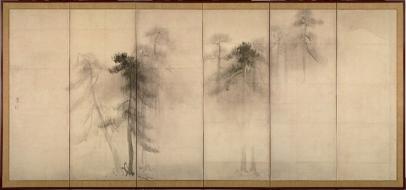
4 minute read
THE CLOSE RELATIONSHIP BETWEEN TREES, ART & CULTURE
Olivia Jin (OHS)
The tree has been a common source of inspiration for most artists since the emergence of art itself, one that is visibly ingrained into our landscape due to their widespread distribution. Most paintings, across all styles, are likely to include a tree, and most artists have spent time studying how to reproduce a tree on paper. We have long perceived trees as symbols of life, regrowth and strength due to their seasonal death and re-emergence. A more conventional reason for influence of trees in art is because of their abundance - they are crucial for any art involving landscape and nature, and their complex appearance, difficult to transpose onto canvas, gives an opportunity to hone manual and observational skills. It could be seen that the history of the close relation between people, trees and art mostly arises from a deep emotional appreciation we have for trees, and their unexplained special meaning to us. Historically, trees have been harnessed as symbols since antiquity. The cyclic nature of a tree’s seasonal death and regrowth have presented them as symbols of resurrection; a common motif within many cultures’ mythology usually involves a ‘tree of life,’ or ‘world tree’ connecting the human world with the supernatural. This concept has contributed to the foundation for mythology and religion to emerge across civilisations, consequently, trees have become a focal point of religious and visual art. Famous paintings depicting a ‘tree of life’ include Gustav Klimt’s The Tree of Life, painted in 1905. The symbolic painting represents the relationship between heaven, earth and the underworld, with swirling branches tangled amongst one another expressing the complexity of life. own language through tree symbolism: in the West, Olive trees are labelled by Christians as a symbol of peace, while Cypress trees have been coined as symbols of death long before Christianity. The Palm is closely associated with salvation and Paradise and is typically painted into biblical scenes of the Entry into Jerusalem, such as this fresco painted by the renaissance artist Giotto.

Entry into Jerusalem, Giotto (1305) There is a link between how trees are used as symbols of characteristics or values and their emotional presence within a piece of artwork – in particular, trees have a certain atmospheric quality that is explored through art. Significantly, Romantic art uses trees and nature for emotive purpose. The artist, Maxim Vorobiev, painted Oak Fractured by Lightning after the death of his wife. The imagery of the Oak being struck by lightning clearly symbolises the pain he felt upon his wife’s death.
Maxim Vorobiev, Oak Fractured by Lightning (1842) While Romantic art was meant to capture emotive scenery in a dramatized light, traditional Japanese art promotes peace, harmony and spirituality; infamously, Japanese culture has always been closely linked to nature. The focus on nature in ancient paintings capture the traditional aesthetics of Japanese culture, reflecting the values shared by artists during the period. When Hasegawa Tohaku painted his Pine Trees, Japan was experiencing an artistic movement emphasising traditional simplicity and minimalism.
Gustav Klimt, The Tree of Life (1905) Myth and legend are closely linked to trees - sacred trees have an importance presence in many ancient myths, the subject of most ancient religious art and subsequent art periods such as renaissance and neoclassical art. It seems religion has created its very


Hasegawa Tohaku, Pine Trees left screen (1595) A famous example of an artist with a close relation to nature include the works of impressionist painter Van Gogh. He painted his Olive Trees series at the height of his illness, to find mental and emotional relief through reconnecting with nature. Van Gogh believed the growth cycle of an olive tree embodied the cycle of human life. Despite being generally dismissive of religion, Van Gogh found great meaning and spirituality while immersed in nature. Van Gogh’s later works demonstrate how a close spiritual link with nature can impact the emotions of an artist.

Vincent Van Gogh, Landscape with Olive Trees (1889) The important cultural values we ascribe to different tree species across the world has inextricably been expressed through the art we create. This is still evident today, especially regarding environmental issues such as deforestation. Art is a common medium used for activism and the growing environmental movement has inspired a huge quantity of art, demonstrating how trees have also been used in art for political purposes. As art continues to evolve, one of the key influences on art of future generations may be the changing environment, and the greater prevalence of the preservation of trees and the natural world. Bibliography
Russell, C. (1981). The Life Tree and the Death Tree. London: Taylor & Francis, Ltd Martin, L.H. (2016) Past Minds: Studies in Cognitive Historiography. New York: Routledge Fărcaş, C. & Cristea, V. & Farcas, S. & Ursu, T. & Roman, A. (2015). The Symbolism of Garden and Orchard Plants and their Representation in Paintings. Contribuţii Botanice. 50. 189-200. Pickvance, R. (1986) Van Gogh in Saint-Rémy and Auvers. New York: Metropolitan Museum of Art Parkes, G & Loughnan, A. (2018) “Japanese Aesthetics”, The Stanford Encyclopedia of Philosophy (Winter 2018 Edition), Edward N. Zalta (ed.), URL = <https://plato.stanford.edu/archives/win2018/ entries/japanese-aesthetics/> https://arthive.com/encyclopedia/123~The_tree_ as_a_symbol_in_art
Images:
https://www.gustav-klimt.com/The-Tree-Of-Life.jsp https://medium.com/@kevinshau/hasegawa-tohakuspine-trees-minimalism-and-art-in-warring-states-japan6763cd96baa7
https://www.wikiart.org/en/maxim-vorobiev/oakfractured-by-a-lightning-allegory-on-the-artist-s-wifedeath-1842 https://www.artway.eu/content. php?id=1121&lang=en&action=show https://www.vincentvangogh.org/landscape-with-olivetrees.jsp





